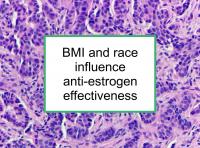Preliminary results of a new study indicate that lower body mass index (BMI) and non-Hispanic white ethnicity are associated with greater decrease in tumor size in response to neoadjuvant endocrine therapy. Women with ductal breast cancer might also have a more favorable response that those with lobular breast cancer.
Neoadjuvant endocrine therapy (aromatase inhibitor or tamoxifen treatment that is administered before surgery to remove the tumor) is increasingly used to the treat breast cancer.
The retrospective study was designed to investigate the association between ethnicity and body weight on response to neoadjuvant endocrine therapy in postmenopausal breast cancer patients with large estrogen receptor positive (ER+) tumors. There is a need to define which patients will benefit the most from this form of therapy.
To conduct the study, the authors reviewed medical records from University of Miami/Jackson Memorial Hospital for the period 1998 to 2011. The study included 62 postmenopausal women with median age 62. Response to neoadjuvant hormonal therapy was evaluated by comparing the palpable breast mass size at presentation with pathological tumor size in surgical specimens.
Response was ranked as either No Response (no change or increase in tumor size), Moderate Response (up to 50% decrease in size), and Good Response (> 50% decrease in size). The response data was analyzed by BMI, endocrine therapy type, ethnicity, and breast cancer type. The women were categorized as stage II (24.2% of the study population), stage IIIA (25.8%), stage IIIB (35.5%), and stage IIIC (6.5%). A total of 14.5% were treated with tamoxifen and 85.5% used an aromatase inhibitor.
A total of 22.6% of the women had No Response to neoadjuvant endocrine therapy, 43.5% experienced Moderate Response, and 33.9% had Good Response. Height and weight information was available for 52 of the women. BMI was found to be significantly higher in the No Response group compared to the Good Response group among patients receiving an aromatase inhibitor (average BMI: 38.68 compared to 27.56). Analysis of both aromatase inhibitor and tamoxifen treated patients yielded similar results.
The proportion of Good Response was found to be higher in the white compared to the African-American population (40.4% compared to 14.3%). Also, the rate of No Response was higher among African Americans (50.0% compared to 14.9%).
The average size change also tended to be more favorable in women with ductal rather than lobular carcinomas (34.8% decrease compared to 8.7% increase), but this result did not reach statistical significance.
The authors conclude that lower BMI and white ethnicity were associated with higher frequency of greater than 50% decrease in tumor size in response to neoadjuvant endocrine therapy. No association was found between tumor size change and tumor stage, progesterone receptor (PR) status or HER2 expression.
